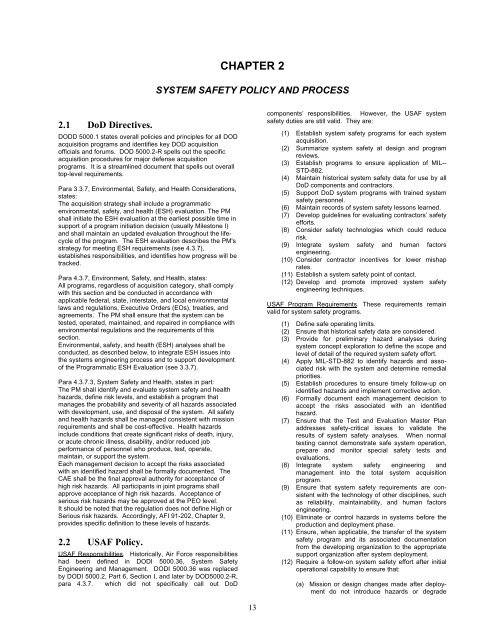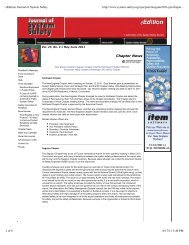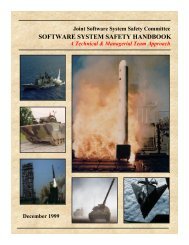Air Force System Safety Handbook - System Safety Society
Air Force System Safety Handbook - System Safety Society
Air Force System Safety Handbook - System Safety Society
You also want an ePaper? Increase the reach of your titles
YUMPU automatically turns print PDFs into web optimized ePapers that Google loves.
2.1 DoD Directives.<br />
DODD 5000.1 states overall policies and principles for all DOD<br />
acquisition programs and identifies key DOD acquisition<br />
officials and forums. DOD 5000.2-R spells out the specific<br />
acquisition procedures for major defense acquisition<br />
programs. It is a streamlined document that spells out overall<br />
top-level requirements.<br />
Para 3.3.7, Environmental, <strong>Safety</strong>, and Health Considerations,<br />
states:<br />
The acquisition strategy shall include a programmatic<br />
environmental, safety, and health (ESH) evaluation. The PM<br />
shall initiate the ESH evaluation at the earliest possible time in<br />
support of a program initiation decision (usually Milestone I)<br />
and shall maintain an updated evaluation throughout the lifecycle<br />
of the program. The ESH evaluation describes the PM's<br />
strategy for meeting ESH requirements (see 4.3.7),<br />
establishes responsibilities, and identifies how progress will be<br />
tracked.<br />
Para 4.3.7, Environment, <strong>Safety</strong>, and Health, states:<br />
All programs, regardless of acquisition category, shall comply<br />
with this section and be conducted in accordance with<br />
applicable federal, state, interstate, and local environmental<br />
laws and regulations, Executive Orders (EOs), treaties, and<br />
agreements. The PM shall ensure that the system can be<br />
tested, operated, maintained, and repaired in compliance with<br />
environmental regulations and the requirements of this<br />
section.<br />
Environmental, safety, and health (ESH) analyses shall be<br />
conducted, as described below, to integrate ESH issues into<br />
the systems engineering process and to support development<br />
of the Programmatic ESH Evaluation (see 3.3.7).<br />
Para 4.3.7.3, <strong>System</strong> <strong>Safety</strong> and Health, states in part:<br />
The PM shall identify and evaluate system safety and health<br />
hazards, define risk levels, and establish a program that<br />
manages the probability and severity of all hazards associated<br />
with development, use, and disposal of the system. All safety<br />
and health hazards shall be managed consistent with mission<br />
requirements and shall be cost-effective. Health hazards<br />
include conditions that create significant risks of death, injury,<br />
or acute chronic illness, disability, and/or reduced job<br />
performance of personnel who produce, test, operate,<br />
maintain, or support the system.<br />
Each management decision to accept the risks associated<br />
with an identified hazard shall be formally documented. The<br />
CAE shall be the final approval authority for acceptance of<br />
high risk hazards. All participants in joint programs shall<br />
approve acceptance of high risk hazards. Acceptance of<br />
serious risk hazards may be approved at the PEO level.<br />
It should be noted that the regulation does not define High or<br />
Serious risk hazards. Accordingly, AFI 91-202, Chapter 9,<br />
provides specific definition to these levels of hazards.<br />
2.2 USAF Policy.<br />
USAF Responsibilities. Historically, <strong>Air</strong> <strong>Force</strong> responsibilities<br />
had been defined in DODI 5000.36, <strong>System</strong> <strong>Safety</strong><br />
Engineering and Management. DODI 5000.36 was replaced<br />
by DODI 5000.2, Part 6, Section I, and later by DOD5000.2-R,<br />
para 4.3.7. which did not specifically call out DoD<br />
CHAPTER 2<br />
SYSTEM SAFETY POLICY AND PROCESS<br />
13<br />
components’ responsibilities. However, the USAF system<br />
safety duties are still valid. They are:<br />
(1) Establish system safety programs for each system<br />
acquisition.<br />
(2) Summarize system safety at design and program<br />
reviews.<br />
(3) Establish programs to ensure application of MIL--<br />
STD-882.<br />
(4) Maintain historical system safety data for use by all<br />
DoD components and contractors.<br />
(5) Support DoD system programs with trained system<br />
safety personnel.<br />
(6) Maintain records of system safety lessons learned.<br />
(7) Develop guidelines for evaluating contractors’ safety<br />
efforts.<br />
(8) Consider safety technologies which could reduce<br />
risk.<br />
(9) Integrate system safety and human factors<br />
engineering.<br />
(10) Consider contractor incentives for lower mishap<br />
rates.<br />
(11) Establish a system safety point of contact.<br />
(12) Develop and promote improved system safety<br />
engineering techniques.<br />
USAF Program Requirements. These requirements remain<br />
valid for system safety programs.<br />
(1) Define safe operating limits.<br />
(2) Ensure that historical safety data are considered.<br />
(3) Provide for preliminary hazard analyses during<br />
system concept exploration to define the scope and<br />
level of detail of the required system safety effort.<br />
(4) Apply MIL-STD-882 to identify hazards and associated<br />
risk with the system and determine remedial<br />
priorities.<br />
(5) Establish procedures to ensure timely follow-up on<br />
identified hazards and implement corrective action.<br />
(6) Formally document each management decision to<br />
accept the risks associated with an identified<br />
hazard.<br />
(7) Ensure that the Test and Evaluation Master Plan<br />
addresses safety-critical issues to validate the<br />
results of system safety analyses. When normal<br />
testing cannot demonstrate safe system operation,<br />
prepare and monitor special safety tests and<br />
evaluations.<br />
(8) Integrate system safety engineering and<br />
management into the total system acquisition<br />
program.<br />
(9) Ensure that system safety requirements are consistent<br />
with the technology of other disciplines, such<br />
as reliability, maintainability, and human factors<br />
engineering.<br />
(10) Eliminate or control hazards in systems before the<br />
production and deployment phase.<br />
(11) Ensure, when applicable, the transfer of the system<br />
safety program and its associated documentation<br />
from the developing organization to the appropriate<br />
support organization after system deployment.<br />
(12) Require a follow-on system safety effort after initial<br />
operational capability to ensure that:<br />
(a) Mission or design changes made after deployment<br />
do not introduce hazards or degrade




